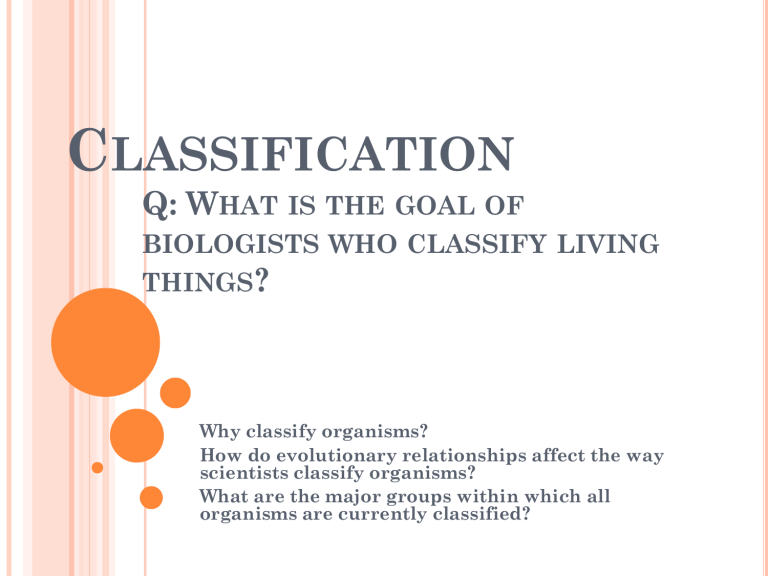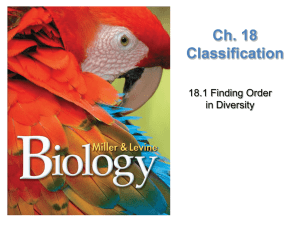Classification Q: What is the goal of biologists who

C
LASSIFICATION
Q: W HAT IS THE GOAL OF
BIOLOGISTS WHO CLASSIFY LIVING
THINGS ?
Why classify organisms?
How do evolutionary relationships affect the way scientists classify organisms?
What are the major groups within which all organisms are currently classified?
A: T O F IND O RDER IN D IVERSITY
Q: What is one thing we can do to “find order in a diverse world”?
A: Give it a name and describe it
This is one of the most basic skills a scientist does, but exactly how do scientists name things?
C OMMON N AMES
Depending where you live, common names are assigned to living things—but this presents a problem because common names may vary from place to place and among languages
Examples:
bobcat, cougar, puma, mountain lion all refer to the same type of cat
In the UK a buzzard is a hawk, while in the US it is a vulture
Maryland’s state flower—black eyed Susan, yellow cornflower
A SSIGNING S CIENTIFIC N AMES
To be useful, each scientific name must refer to one and only one species, and everyone must use that same name for that species.
It must be written in Latin
D ICHOTOMOUS K EYS
One of the earliest classification systems
Consists of a series of paired statements or questions that describe alternative possible characteristics of an organism.
The paired statements usually describe the presence or absence of a certain visible characteristics or structures.
Each set of choices is arranged so that each step produces a smaller subset.
U SING A D ICHOTOMOUS K EY
How would you describe this leaf?
2a
2b
3a
3b
4a
4b
5a
5b
6a
6b
Step Leaf Characteristics
1a
1b
Compound leaf (leaf divided into leaflets)…go to step 2
Simple leaf (leaf not divided into leaflets)…go to step 4
Leaflets all attached at a central point
Leaflets attached at several points…go to step 3
Leaflets tapered with pointed tips
Leaflets oval with rounded tips
Veins branched out from one central point…go to step 5
Veins branched off main vein in middle of the leaf…go to step 6
Heart-shaped leaf
Star-shaped leaf
Leaf with jagged edges
Leaf with smooth edges
Tree
Birch
B INOMIAL N OMENCLATURE
Definition: having a two-part scientific name
Written in italic if typing or underlined if handwritten
First word (of name) is capitalized and the second word (of name) is lower-cased
Example: Felis concolor or Homo saphien
Created by a Swedish botanist named Carolus
Linnaeus
B INOMIAL N OMENCLATURE CONT .
Polar bear’s scientific name is Ursus maritimus
Ursus is the genus (plural: genera) to which the polar bear belongs
A genus is a group of similar species
The genus Ursus contains 4 species of bears including Ursus arctos—the brown bear or
“grizzly”
The second part of the name is the species
A species is defined as a group of individuals capable of interbreeding and producing fertile offspring
The species name is often a description of an important trait or the organism’s habitat.
Species and subspecies of Ursus
American Black Bear , Ursus americanus
Cinnamon Bear , Ursus americanus cinnamomum
Kermode Bear , Ursus americanus kermodei
Brown Bear , Ursus arctos
Grizzly Bear , Ursus arctos horribilis
Kodiak Bear , Ursus arctos middendorffi
Polar Bear , Ursus maritimus (earlier
Thalarctos maritimus)
Asiatic Black Bear , Ursus thibetanus, or
Selenarctos thibetanus
A hybrid between grizzly bears and polar bears has also been recorded (known commonly as a pizzly bear). The official name is a grizzly-polar bear hybrid .
C LASSIFYING S PECIES INTO L ARGER
G ROUPS
The science of naming and grouping organisms is called systematics
The goal of systematics is to organize living things into groups (called taxa; singular: taxon) that have biological meaning
H OW DID L INNAEUS GROUP SPECIES INTO
LARGER TAXA ?
Classification System based on a hierarchy or set of ordered ranks (smallest to largest):
Species
Genus
Family
Order
Class
Phylum (Division)
Kingdom
P ROBLEMS WITH T RADITIONAL
(L INNAEAN ) C LASSIFICATION
Linnaean classification emphasized the overall similarities and differences to classify an organism
Modern systematists apply Darwin’s ideas
(descent with modification) to classification and try to look beyond simple similarities and differences to ask questions about evolutionary relationships (i.e. who is more closely related to each other)
1.
2.
L ESSON A SSESSMENT
3.
4.
5.
6.
Identify two goals of systematics.
Why do the common names of organisms—like daisy or mountain lion—often cause problems for scientists?
The scientific name of the sugar maple is Acer
saccharum. What does each part of the name designate?
List the ranks of the Linnaean system of classification from largest to smallest.
In which group of organisms are the members more closely associated—kingdom or order. Explain your answer.
Why might modern biologists have a problem with the term “species”?
T ODAY ’ S M AIN Q UESTION :
H OW DO EVOLUTIONARY RELATIONSHIPS AFFECT THE WAY
SCIENTISTS CLASSIFY ORGANISMS ?
Guiding Questions:
What is the goal of evolutionary classification?
What is a cladogram and how do you interpret a cladogram?
How are DNA sequences used in classification?
M ODERN E VOLUTIONARY C LASSIFICATION
Remember: Linnaean classification system is based on similarities and differences
Remember: Darwin’s “Tree of Life” suggests that all living things are related to each other through evolutionary relationships back to a common ancestor
This presents some problems in how we classify living things.
Example: Birds and Reptiles
W HAT IS THE GOAL OF EVOLUTIONARY
CLASSIFICATION ?
The concept of descent with modification (by
Darwin) led to the study of phylogeny—the evolutionary history of lineages—which led to phylogenetic systematics (aka evolutionary classification).
The goal of phylogenetic systematics is to group species into larger categories that reflect lines of evolutionary descent, rather than overall similarities and differences.
E VOLUTIONARY C LASSIFICATION
Places organisms into higher taxa whose members are more closely related to one another than they are to members of any other group.
The larger the taxon is, the farther back in time all of its members shared a common ancestor.
Classifying organisms according to these above rules places them into groups called clades.
A monophyletic clade is a group of species that includes a single common ancestor and all descendants of that ancestor—living and extinct.
Paraphyletic clades include a common ancestor but are missing one or more descendants.
W HAT IS A CLADOGRAM ?
A diagram that links groups of organisms by showing how evolutionary lines or lineages branched off from common ancestors.
B UILDING C LADOGRAMS
Speciation
The process by which one ancestral species splits into two new ones
This is the basis by which each branching point or node is made in a cladogram
The node represents the last point at which the two new lineages above the node shared a common ancestor
The bottom or “root” of a cladogram represents the common ancestors shared by all organisms in the cladogram
Derived Character:
A trait that arose in the most recent common ancestor or a particular lineage and was passed along to its descendants.









